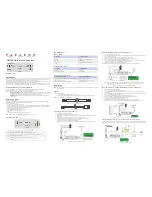
1.
DISCLAIMER OF LIABILITY
The installation, handling and use of Trina Solar Crystalline modules are beyond company control. Trina Solar does
not assume any responsibility for loss, damage, injury or expense resulting from the improper installation, handling,
use or maintenance.
Trina Solar assumes no responsibility for any infringement of patents or other rights of third parties that may result
from use of the module. No license is granted by implication or under any patent or patent rights.
Specifications are subject to change without prior notice.
2.
SAFETY PRECAUTIONS
Potentially lethal DC voltages can be generated whenever PV Modules are exposed to a light source therefore,
avoid contact with electrically active parts and be sure to isolate live circuits before attempting to make or break any
connections.
Only authorized and trained personnel should have access or perform work on the modules or solar system.
When working on electrical connections, remove all metallic jewelry, use properly insulated tools and wear
appropriate personal protective equipment to reduce the risk of electric shock.
Do NOT stand or step on, damage or scratch the front or backside surfaces of the module.
Broken modules cannot be repaired and contact with any module surface or frame can lead to electrical shock. Do
NOT use a module with broken glass or torn substrate.
Do NOT disassemble the modules or remove any part of the module.
Protect the electrical plug contacts against corrosion and soiling. Make sure that all connectors are corrosion free
and clean before making the connection.
Do NOT install or handle modules when they are wet or during periods of high wind.
Ensure sure that all connections are securely made with no gap between the contacts. Any gap can result in
electrical arcing that can cause a fire hazard and/or an electric shock.
Make sure that the polarity of each module or a string is not reversed considering the rest of the modules or strings.
Do NOT artificially concentrate sunlight on these solar modules.
Trina Solar modules are certified for operating in Class A installations at voltages below 1000Vdc. This maximum
voltage should not be exceeded at any time and, as the voltage of the module increases, above data sheet values, at
operating temperatures below 25°C, then these need to be taken into account when designing a PV system.
Do NOT use water to extinguish fires of an electrical origin.
Under normal conditions, a solar photovoltaic module is likely to produce more current and /or voltage than
reported under standard test conditions. Accordingly, the value of Isc marked on this module should be multiplied
by a factor of 1.25 when determining the conductor current ratings, fuse sizes and size of controls connected to the
SPV output.
3.
UNPACKING AND STORAGE
At time of receipt, verify that the product delivered is in fact the product ordered the product name, subname, and
serial number of each laminate are clearly marked on the outside of each packing box.
Leave the product in its original packing box until you are ready to install.
Store packing boxes in a clean, dry area with relative humidity below 85% and ambient temperatures between -
20°C and 40°C.
Do NOT stack more than the maximum amount of allowable pallets on top of each other.
At the installation site, take care to keep modules and particular their electrical contacts clean and dry before
installation. If connector cables are left in damp conditions then the contacts may corrode. Any module with
corroded contacts should not be used.
If pallets are stored temporarily outside then place a protective covering over the pallet to protect it from direct
weathering and do not stack more than 1 pallet high.
Two people are required to unpack the modules from the packing box, when handling modules always use both
hands.
Do NOT use a knife to cut the zip-ties, but use wire cutting pliers.
Do NOT place modules directly on top of each other.
1


























